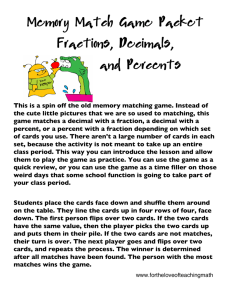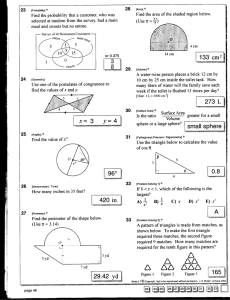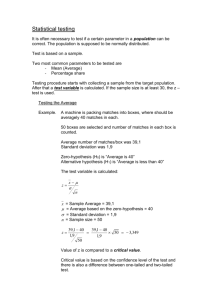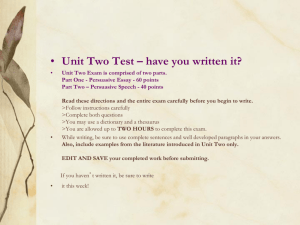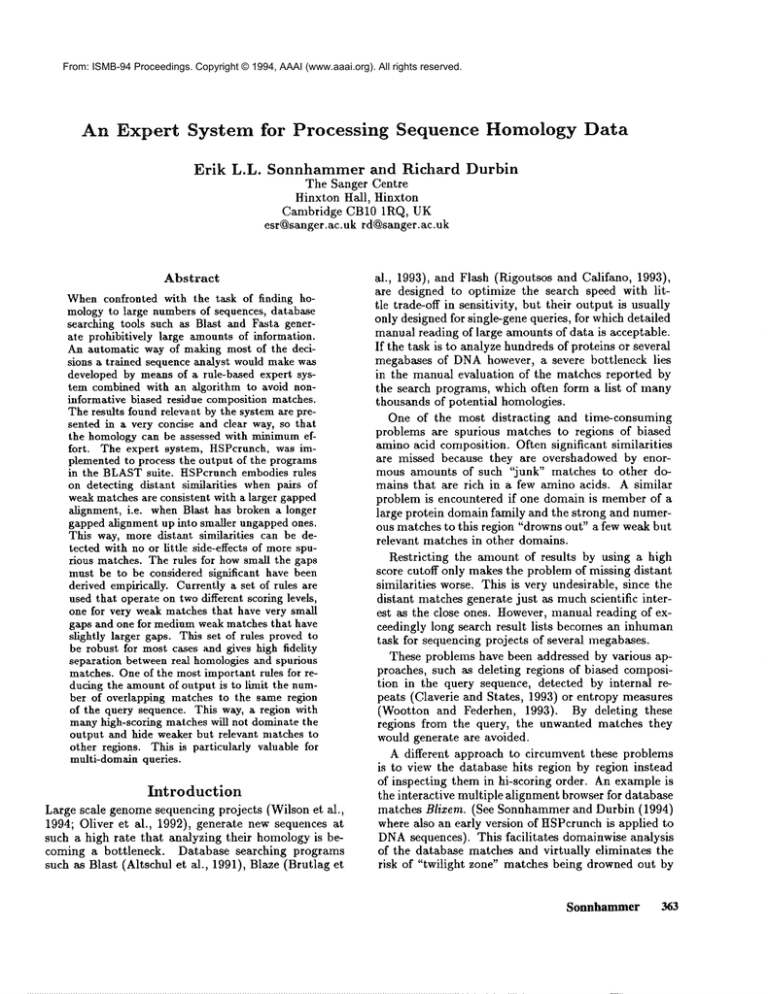
From: ISMB-94 Proceedings. Copyright © 1994, AAAI (www.aaai.org). All rights reserved.
An Expert
System
for
Processing
Sequence
Homology
Data
Erik L.L. Sonnhammerand Richard Durbin
The Sanger Centre
Hinxton Hall, Hinxton
Cambridge
CB10 1RQ, UK
esr@sanger.ac.uk
rd@sanger.ac.uk
Abstract
When confronted with the task of finding homology to large numbers of sequences, database
searching tools such as Blast and Fasta generate prohibitively large amounts of information.
An automatic way of making most of the decisions a trained sequence analyst would make was
developed by means of a rule-based expert system combined with an algorithm to avoid noninformative biased residue composition matches.
The results found relevant by the system are presented in a very concise and clear way, so that
the homology can be assessed with minimumeffort. The expert system, HSPcrunch, was implemented to process the output of the programs
in the BLASTsuite. HSPcrunch embodies rules
on detecting distant similarities
when pairs of
weak matches are consistent with a larger gapped
alignment, i.e. when Blast has broken a longer
gapped alignment up into smaller ungapped ones.
This way, more distant similarities
can be detected with no or little side-effects of more spurious matches. The rules for how small the gaps
must be to be considered significant
have been
derived empirically. Currently a set of rules are
used that operate on two different scoring levels,
one for very weak matches that have very small
gaps and one for medium weak matches that have
slightly larger gaps. This set of rules proved to
be robust for most cases and gives high fidelity
separation between real homologies and spurious
matches. One of the most important rules for reducing the amount of output is to linlit the number of overlapping matches to the same region
of the query sequence. This way, a region with
many high-scoring matches will not dominate the
output and hide weaker but relevant matches to
other regions. This is particularly valuable for
multi-domain queries.
Introduction
Large scale genome sequencing projects (Wilson et al.,
1994; Oliver et al., 1992), generate new sequences at
such a high rate that analyzing their homology is becoming a bottleneck.
Database searching
programs
such as Blast (Altschul et al., 1991), Blaze (Brutlag
al., 1993), and Flash (RJgoutsos and Califano, 1993),
are designed to optimize the search speed with little trade-off in sensitivity,
but their output is usually
only designed for single-gene queries, for which detailed
manual reading of large amounts of data is acceptable.
If the task is to analyze hundreds of proteins or several
megabases of DNAhowever, a severe bottleneck
lies
in the manual evaluation
of the matches reported by
the search programs, which often form a list of many
thousands of potential homologies.
One of the most distracting
and time-consuming
problems are spurious matches to regions of biased
amino acid composition. Often significant
similarities
are missed because they are overshadowed by enormous amounts of such "junk" matches to other domains that are rich in a few amino acids. A similar
problem is encountered if one domain is member of a
large protein domain family and the strong and numerous matches to this region "drowns out" a few weak but
relevant matches in other domains.
Restricting
the amount of results
by using a high
score cutoff only makes the problem of missing distant
similarities
worse. This is very undesirable, since the
distant matches generate just as much scientific
interest as the close ones. However, manual reading of exceedingly long search result lists becomes an inhuman
task for sequencing projects of several megabases.
These problems have been addressed by various approaches, such as deleting regions of biased composition in the query sequence, detected by internal
repeats (Claverie and States, 1993) or entropy measures
(Wootton and Federhen, 1993). By deleting
these
regions from the query, the unwanted matches they
would generate are avoided.
A different
approach to circumvent these problems
is to view the database hits region by region instead
of inspecting them in hi-scoring order. An example is
the interactive multiple alignment browser for database
matches Blizem. (See Sonnhammer and Durbin (1994)
where also an early version of HSPcrunch is applied to
DNAsequences). This facilitates
domainwise analysis
of the database matches and virtually
eliminates the
risk of "twilight zone" matches being drowned out by
Sonnhammer
363
other regions with numerous matches.
This paper describes an expert system which "weeds
out" as manyunwanted matches a,s possible. It is currently implemented to work on output from the programs Blastp, Blastx, Blastn and Tblastn which produce a list of ungapped alignments, or ItSPs (ltighscoring SegmentPairs). A set of rules are applied to
filter out as many unwanted matches as possible, by
compensating the score for compositional bias and by
limiting the number of matches in congested regions.
Weakmatches that are potentially distant similarities
are kept, however, if they support each other as being
conserved regions of a gapped alignment. After filtering, the accepted matches from Blast can be viewed
either as a graphical "’Big Picture" display with one
database sequence per line, showing matches symbolically as lines or a detailed pairwise alignment ~ la
Blast, but sorted N- to C-terminal.
HSPcrunch
rules
Biased composition
Biased composition HSPs are detected by a rule that
comparesthe score of the HSPwith the score of an tISP
with no composition bias, in relation to the aminoacid
composition of the HSPin question.
The expected score of an tISP Se~,p is the average
score two random sequences of that length and amino
acid composition would have. For a typical HSP the
expected score is negative, but if the composition is
very biased the expected score may be positive. The
expected score is calculated the following way: Two
vectors Q and S with the observed frequencies of the
amino acids in the two sequences making up the lISP
are constructed. The vectors are then scored against
each other so that
20
i=/
2O
j=l
where L is the length of the HSPand Mis the scoring
matrix. This method yields the same result as random
shuffling methods would asymptotically, but is faster.
To estimate if the score S of the HSPis the result of
biased composition, we calculate the bias-ratio L~:
Z-
S - Sexp
Sv LM,~where Mexv is the frequency-weighted expected score
of random (unbiased) sequences according to the scoring matrix used. For BLOSUM62,
.,’vl~p = -0.945.
fl can be used as an index of how biased the composition of the HSP is. As a rule, ~ < 0.75 is a sign
that the HSP has a biased composition and should be
rejected. ’_Fable 1 shows to what degree the unwanted
biased composition HSPsare removed for different values of ft. For values of~ above .75, loss of goodmatches
with slight bias becomes a problem.
364 ISMB--94
HSP_dlst
~
HSP g,mp
Figure 1: Adjacency of neighbor HPSs is checked
by applying rules to the inter-liSP parameters shown
here. ltSP_dist is the smallest distance between the
two segments of protein A or B. HSP_gapis the shift.
of protein A relative to protein B.
HSP adjacency
Low-scoring HSPs may be due to fragmentation caused
by gaps in a larger alignment. Since these gapped
alignments are potentially real, a lower score threshold
should be used for adjacent HSPsthat can be concatenated within some limits of allowed overlaps and gaps
in the query and subject sequences. Figure [ depicts
two HSPsof the proteins A and B.
Adjacency is verified if A1 is N-terminal to A2 and
B1 is N-terminal to B2. If not, there is no evidence
that the IISPs are part of a larger gapped alignment
and the HSPsare treated separately. The definition of
adjacency completely depends on the chosen parameters for how big the gaps and overlaps between tISP
may be. After testing various rules of adjacency, the
most efficient combinationof rules proved to be to test
the adjacencies on two levels. A pair of neighboring
HSPsare said to be either non-adjacent, loosely adjacent (on the correct side, but distant) or stringently
adjacent. The parameter that gave the best results in
terms of least missed homologies and most rejection of
false ones are: liSP_gap < 25 for both loose and stringent adjacency. For loose adjacency, -20 < HSP_dist
< 300 and for stringent adjacency -20 < HSP_dist <
50.
With no adjacency at all the score of an HSPis required to be at least 75. With loose adjacency (defined
below), the score cutoff is f;0, while with stringent adjacency we accept HSPs scoring 40. Note that these
values are strictly meant for protein-protein HSPs.
For DNA-DNA
and DNA-protein other thresholds are
nsed.
Coverage cutoff
If the segment in the query of an HSPalready is covered by many other FISPs that score higher, the HSP
is rejected to avoid redundant data, which can happen
if the query is part of a family with many members.
Welimit the coverage by default to l0 fold. If every
residue in the query has this coverage already, the HSP
Blastp cutoff
Blastp HSPS
0.1
0.2
0.3
0.4
0.5
0.6
0.7
0.8
0.9
YMH5_CAEEL
64t
3465
biased [good
331-132
298 - 132
221-132
133- 132
23-.- 132
7 - 132
0 - 132
0 - 132
0 - 129
YMH5_CAEEL
4O
30125
biased [good
487 - 179
454 - 179
377 - 179
285 - 179
117 - 179
27 - 179
8 - 179
4 - 179
0 - 170
B0284.1
4O
10377
biased I good
292 - 3
288 - 3
277 - 3
251-- 3
191 - 3
67 - 3
15-3
3--3
0-0
CAI4_CAEEL
GRP_ARATtI
65t
5903
biasedlgood
2503-- 27
2485-27
2443 - 27
2418 - 27
2378 27
2255 - 27
1867 - 27
623 - 25
22 - 22
59t
4427
biased [self
1625 - 1
847 - 1
326 - l
66 - 1
15 - 1
3-0
0-0
0-0
0-0
Table 1: Separation of biased composition matches from good ones by HSPcrunchas a function of the bias-ratio ft.
The numbers refer to counts of HSPs that passed the IiSPcrunch adjacency criteria. No coverage limit was used.
YM]:I5_CAEEL
(Swissprot P34472) has a stretch of biased composition (acid-rich) in the N-terminus as well
reverse transcriptase domain and 3 C-type lectin domains (see Figure 2). Most of the lectin domains are missed
when using the default Blastp score cutoff but appear when it is is lowered to 40. The extra HSPs produced this
way (26660) are efficiently filtered out by HSPcrunch. B0284.1 (WormpepCE00650) has a charged-residue biased
region. CA14_CAEEL
(Swissprot P17139) is a collagen, containing mainly [Gxy],~ repeats. Although these matches
have biased composition, they are to other collagens, and it is therefore useful that HSPcrunchdoes not reject all
of them. GRP_ARATtI
is the most biased composition protein in Swissprot 28 (72% Glycine, relative entropy 2.0
bits). In this extreme case even the match to itself does not pass the biased composition test when/3 > .6. t: The
used Blastp cutoff was calculated by Blastp.
is rejected. Ifa set of liSPs are adjacent, all HSPsmust
be covered to be rejected.
Displaying results
HSPcrunch currently supports the following output
formats:
¯ As a graphical "Big Picture" of the relevant matches,
with one database sequence per line as shownin Figure 2. This way one rapidly gets a good picture of
which proteins match a certain region of the query.
In this display, matches that are consistent with the
adjacency rules are combined onto one line, and the
sum of their scores is given as the score. The number
of adjacent segments is also shown. Non-adjacent
HSPsare displayed on separate lines. If an HSPwith
a positive expected score passes the biased composition filter, its score will be markedby an asterisk.
¯ As a listing of accepted lISP alignments in N to
C-terminal order. This verbose ASCII output of
HSPcrunch is shown Figure 3a. The layout has been
designed to be easy to read as well as easy to parse
by other programs. Instead of sorting the HSPs in
score order, like Blast does, HSPcrunchsorts them
by position from N to C-ternainus in the database
sequence. This way a much better appreciation of
the global alignment with gaps is gained, if it exists.
¯ View the HSPs as a multiple sequence alignment
in the X-windows viewer BILxem (Sonnhammer and
Durbin, 1994), either directly or called from ACEDB
(Mieg and Durbin, unpublished).
¯ One line per HSPoutput, for parsing by other programs. A variety of one line formats are supported,
of which one is shownin Figure 3b.
Methods and Materials
For generating the HSPs, Bla,stp version 1.3.11 was
used. The B parameter was set to a high value so
that it does not limit the number of ttSPs reported,
and the S (score cutoff) was usually set to 40. The
protein sequence database searched, Swir, is a lowredundancy collection of sequences from SwissProt,
PIR and Wormpep. Redundancy was removed by a
program DBcomm,which rejected any sequence from
PIR that was identical to or included in any Wormpep
or SwissProt entry.
Release 5 of swir consisted of 57115 sequences, consisting of 781 sequences from Wormpeprelease 4, 35488
sequences from SwissProt release 28 (Bairoch and
Boeckman, 1991) that were not derived from Wormpep, and 20846 sequences from PIR release 38 (Barker
et al., 1992). Wormpepis a Sanger Centrc in-house
database containing all predicted proteins so far from
the C. elegans genomesequencing project.
All programs were written in ANSI C and run on
UNIXworkstations from Silicon Graphics running Irix
4.0.5, and SUNrunning SunOS4.1.3.
Availability
HSPcrunch and auxiliary programs such as Blixem,
Fetch, Seqsplit, Blastunsplit are available by anonymous FTP from ftp.sanger.ac.uk
in /pub/HSPcrunch
Sonnhammer
365
OUERY= YMHB_CAEEL P34472 HYPOTHETICAL 136.3 KD PROTEIN F58A4.5 IN CHROMOSOME III.
[
F40F12.2
1643 1
ZK1236.4
423 3
B34751
453 5
..........
PCl123
320 4
PC1231
329 5
H44490
260 3
$31175
309 4
YTX2_XENLA
137 1
C06E8.4
220 3
RTJK_DROME
343 6
168 2
$20106
MAHR_HUMAN
75 1
MAMA_HUMAN
79 1
B26330
229 4
A32713
358 7
POL2_MOUSE
210 3
$16783
233 4
B34087
274 5
147 2
A44490
304 5
$28721
JUO033
226 4
$27771
263 5
Y2R2_DROME
202 3
B27672
214 4
POLR_DROME
183 3
LININYCCO
199 3
C07A9.1
114 2
- B36186
208 4
E44255
75 1
G44255
77 1
77 1 --TETN_CARSP
TETN HUMAN
76 1 --$23650
160 3
83 2
LECE AMTCR
85 2
- IXA_TRIFL
LECI HUMAN
99 2
LECI MOUSE
88 2
A42230
88 2
LECH RAT
96 2
99 2
ODPI_ECOLI
ANP_OSMMO
90 2
JH0626
90 2
VP3_ROTS1
92 2
LECI_RAT
82 2
- ---
-
--
---
- -
- -
-
[1222
CE00617 REVERSE TRANSCRIPTASE
CE00531 TRANSPOSON TI-2
B34751 MOSQUITO TRANSPOSON
PCl123 BLOODFLUKE PLANORB
PC1231 MOSQUITO TRANSPOSON
H%%490 REVERSE TRANSCRIPTASE
$31175 TRANSPOSON NLRICTH
P14381 TRANSPOSON TX1
CEO0800 RHA-DIRECTED DNA POL
P21328 RNA-DIRECTED DNA POL
$20106 HYPOTHETICALPROTEIN
P22897 MANNOSE RECEPTOR
P22897 MAHNOSE RECEPTOR
B26330 TRANSPOSON I FACTOR
A32713 REVERSE TRANSCRIPTASE
P11369 REVERSE TRANSCRIPTASE
$16783 RETROPOSON LI - RAT
B34087 HYPOTHETICAL PROTEIN
A44490 REVERSE TRANSCRIPTASE
$28721 HYPOTHETICAL PROTEIN
JUO033 HYPOTHETICAL L1PROT
$27771 RNA-DIRECTED DNA POL
P16%2B RETROTRANSPOSABLE ELEM
B27672 RNA-DIRECTED DNA POLY
P16423 POL POLYPROTEIN
P08548 REVERSE TRANSCRIPTASE
CE00502
B36186 TRAHSPOSON
E44255 MANNOSE RECEPTOR
G44255 MANNOSE RECEPTOR
P26258
TETRANECTIN-LIKE
P05452
TETRANECTIN PRECURSOR
$23650
HYPOTHETICAL PROTEIN
P06027
ECHINOIDIN.
P23806
FACTOR IX/X-BINDING
- - P07307
HEPATIC LECTIN H2
- - P24721
HEPATIC LECTIN 2
A42230 LECTIN M-ASGP-BP
- - P02706 HEPATIC LECTIN 1
P06958 PYRUVATE DEHYDROGENASE
Q01758 ANTIFREEZE PROTEIN
JH0626 ANTIFREEZE PROTEIN II
P15736 INNER CORE PROTEIN VP3
- - P08290 HEPATIC LECTIN 2/3)
Figure 2: Big Picture
display of HSPcrunched Blastp results.
The sequence YMH5_CAEEL
(Swissprot
P34472)
was searched against swir5 with a Blastp score cutoff of 40. The domain organization of this prol.ein is C-type
lectin (30-160), an acid-rich stretch (160-540), C-type lectin (540-620), Reverse Transcriptase (650-980.) and
lectin (1080-1150). All matches to the acid-rich stretch were removed by the biased composition rule (/3 = .75).
In the original output from Blastp, the 62 highest-scoring
HSPs were all biased composition rnatches, apart from
the close relatives
F40F12.2 and ZK1236.4 from the same chromosome. Nearly all lectin matches are missed if the
Score cutoff is not lowered from the default 64 to 40. The columns are: Entry name, combined score, nr. of HSPs,
alignment, accession nr. and abbreviated
description.
Sequences from Wormpep include a dot and the ones from
Swissprot an underscore. Other sequences are from P1R,
366
ISMB-94
A
QUERY= YOW3_CAEELLength
= 482
> VIPR_HUMANP32241VASOACTIVE INTESTINAL POLYPEPTIDERECEPTOR1 PRECURSOR(VIP-R-1).
Score=
~uery:
Sbjc~:
=
Score
Query:
Sbjct:
45, Expected score= -30, Matrix_Expected= -30.2, bias-ratio= 1.00, Adjacency= I
VPGVITVVYIFVRSLBq)DVGNCWIENSTVAWI
ZK643.3 309 - 340
VP T+V+ R +D G
NS++ WI
VIPE_HUMAN 265 - 296 VPSTFTHVWTIARIHFEDYGCWDTINSSLWWI
57, Expected score= -10, Matrix_Expected= -28.4, bias-ratio= 0.78, Adjacency= 1
ZK643.3 342 - 371
WMIITPSLLAHGVNLLLLGLIVYILVKKLR
W+I P L ++ VN +L I+ IL++KLE
VIPR_HUMAN 295 - 324 WIIKGPILTSILVNFILFICIIEILLQKLE
Score= 53, Expected
score= -13, Matrix_Expected= -19.8,
Query: ZK643.3 381 - 401
YRKAVRGALMLIPVFGVQQLL
Y + R L+LIP+FGV ++
Sbjct:
VIPR_HUMAN 336 - 356 YSRLAESTLLLIPLFGVHYIM
bias-ratio= 0.91,
Adjacency= 1
Score= 40, Expected score= -38, Matrix_Expected= -35.9, bias-ratio= 1.03, Adjacency= I
ZK643.3 418 - 455
LNGLqGMF~SFIVCYTNRSVVECVLKFWSSHQEKRALG
query:
+ QG V+ + C+ N V + + W
+ LG
Sbjct:
VIPR_HUMAN 376 - 413 VGSFQGFVVAILYCFLNGEVQAELRRKWRRWHLQGVLG
B
45
57
53
40
34.38
43.33
42.86
23.68
309
342
381
418
340
371
401
455
YMHS_CAEEL
YMHS_CAEEL
YMH5_CAEEL
YMH5_CAEEL
265
295
336
376
296
324
356
413
VIPE_HUMAN
VIPE_HUMAN
VIPE_HUMAN
VIPE_HUMAN
...
...
.,.
...
POLYPEPTIDE RECEPTOR...
POLYPEPTIDERECEPTOR...
POLYPEPTIDE RECEPTOR...
POLYPEPTIDE RECEPTOR...
Figure 3: HSP output. A. The alignment format, showing one of the G-protein coupled receptors
that match
YOW3_CAEEL
(Swissprot
P30650). Note that. all of these HSPs would have been missed if the default
Blastp
score cutoff of 59 was used. Expected score: S~xp, Matrix_Expected:
Me,p, bias-ratio:
~, adjacency: 1 if the
adjacency rules are satisfied.
B. Same as A but in a one-line format. The columns are: score, % identity,
query
start, query end, query name, subject start, subject end, subject name and title.
or by sending Email to esr(~sanger.ac.uk.
in/pub/databases/wormpep.
Wormpepis
Discussion
An often heard criticism
of using ungapped alignments
is that distantly related proteins generally can only be
aligned by inserting
gaps. However, the regions which
require gaps usually correspond to loops between secondary structure
elements in the 3-dimensional structure, where the length of the loop may vary. The loop
residues can often not be aligned structurally,
which
makes sequence alignments of these regions rather
meaningless. Also, the results of algorithms that produce gapped alignment depend strongly
on a somewhat arbitrary
gap penalty.
We have therefore
not
attempted to concatenate
adjacent HSPs into gapped
alignments, but feel that most information is already
present in the ungapped HSPs. A further
advantage
of ungapped alignments is that repeated and shuffled
domains in one sequence can be detected,
something
which is often compromised by programs that produce
a gapped alignment.
One drawback of ungapped alignments is the difficulty of calculating an appropriate composite score for
all HSPs with the same protein. Here we put the emphasis on making sure that a series of HSPs are truly
consistent
with a single gapped alignment.
We then
simply add the individual scores. A different approach
is taken by the Blast programs. For n tISPs from the
same database sequence, they calculate
a combinatorial Poisson probability P(n) that they were found
chance. This probability
can be derived analytically
Sonnhammer
367
but their "consistently ordered" criterion (Karlin and
Altsehul, 1993) is muchweaker than our adjacency criteria and falsely high Poigson rankings mayarise from
spurious hits that are not. adjacent, especially those
involving biased composition matches.
An additional practical problem with the t’oisson
probabilities calculated in BLAST
is that they increase
with tile size of the database, because the expected
number of spurious matches increases slowly as the
database grows. However, the true match scores do
not change, and because many of the new sequences
are homologous to existing ones, the Poisson correction often overestimates the drop in significance. In
any case it is more convenient, to work with a measure
of similarity that remains stable for a particular match.
For these reasons we designed HSPcrunch to work only
with the raw scores (which are log odds ratios).
The reduction of redundant results due to large protein families was achieved here by rejecting excess
matches to a given region. A more subtle way of accomplishing this is to search a pre-clustered database.
Instead of finding similarities to every memberof the
family, a single match wouldbe found to the entire family, thus giving the relations to all other membersof the
family, not only the closest relatives. Presently available collections of protein families such as BLOCKS
(Henikoff and Henikoff, 1992) and ProDom(Sonnhammer and Kahn, 1994) could be used for this. Since
the number of protein sequences grows faster than the
numberof families (Green et al., 1993), a pre-clustering
approach seems very appealing. Given a family of proteins, one can build statistical models such as Profiles
or Itidden Markov Models (Krogh et al., 1994) to improve sensitivity.
Whether searching a collection of
aligned families is better than searching against all sequences is however not entirely clear. Sensitivity may
also decrease if the family is not well defined, or if
the query is much closer to one of the members than
to the average of the family. Therefore, we have here
pursued a higher quality of traditional single-sequence
database searching, which most likely will remain an
important tool complementary to family-based searching techniques.
Acknowledgments
The Sanger Centre is supported by the WellcomeTrust
and the MRC.
References
Altschul, S. F.; Gish, W.; Miller, W.; Myers, E. W.;
and Lipman, D. J. 1990. Basic local alignment search
tool. d. Mol. Biol. 215: 403-410.
Bairoch, A. and Boeckmann B. 1991. The SWISSPROTprotein sequence data bank. Nucleic Acids Res.
19: 2247-2249.
Barker, W. C.; George, D. G.; Mewes, H. W.; and
Tsugita A. 1992. The PlR-International protein sequence database. Nucleic Acids Res. 20: 2023-2026.
368
ISMB-94
Brutlag, D. L.: Dautricourt, J. P.; Diaz, R..; Fier, J.;
and St.atom R. 1993. BLAZE(tin): an implementation of the. Snfith-Waterman sequence comparison algorithln on a massively parallel computer. (’omput.
Chem. 17: 203-207.
Claverie, J. M. and States. D. J. 1993. Information
enhancement methods for large scale sequence analysis. Comput. Chem.. 17: 191-201.
Green, P.; Lipman,D. J.; IIillier, 1,.: Waterson, R.;
States, D.; and Claverie, J. M. 1993. Ancient conserved regions in new gene sequences and the protein
databases. Science 259: 1711-1716.
Henikoff, S. and Henikoff, J. G. 1991. Automatic
assembly of protein blocks for database searching. Nucleic Acids Re s. 19: 6565-6572.
Karlin, S. and Altschul, S. F. 1993. Applications and
statistics for multiple high-scoring segments in molecular sequences. Proe. Natl. Acad. Sci. USA90:
5873-5877.
Krogh A.; BrownM.; Mian I. S.; Sjoelander K.; and
llaussler D. 1994. Hidden Markov model in computational biology. Applications to protein modeling, d.
Mol. Biol. 235: 1501-1531.
Oliver, S. G.; Van der Aart, Q..]. M.; AgostiniCarbone, M. L.; Aigle, M.; Alberghina, L.; Alexandraki, I).; Antoine, G.; Anwar. R.; Ballesta, J. P.
G.: Beuit. P.; Berben, G.; Bergantino, E.; Biteau, N.;
Bolle, P. A.; Bolotin-Fnkuhara, M.; Brown.A.; Brown,
A. a. P.; (% al. 1992. The complete DNAsequence of
yeast chromosomeIII. Nature 357: 38-46.
Rigoutsos, I. and Califano, A. 1993. dFLASH:A
Distributed Fast Look-UpAlgorithm for String Homology. IEEE Computational Science and Engineering In
Press.
Sonnhammer,E. L. L and Durbin, R. 1994. A workbench for Large Scale Sequence HomologyAnalysis.
Co mput. Appl. Biosci. In Press.
Sonnhammer, E. L. L. and Kahn, D. 1994. Modular structure of proteins as inferred from analysis of
homology. Protein Science 3: 482-492.
Wilson et al. 1994. 2.2 Mbof contiguous nucleotide
sequence from chromosomeIll for C. clegans. Nature
368: 32-38.
Wootton J.C. and Federhen S. 1993. Statistics of
local complexity in amino acid sequences and sequence
databases. Comput. Chem. 17: 149-163.

